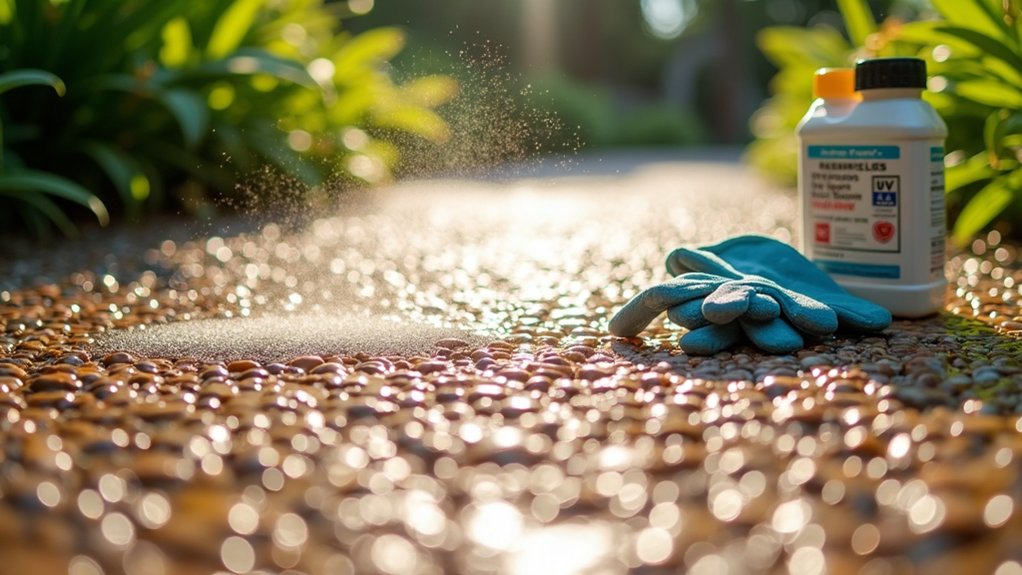Choose UV-resistant resins to prevent fading in resin-bound gravel surfaces – much like applying sunscreen to protect your skin. Use kiln-dried, properly graded aggregates, similar to selecting the right sand grades for concrete. Before laying, ensure surfaces are spotlessly clean and monitor moisture levels, as British weather can be particularly challenging. A stiff brush and gentle wash-down every few months will keep the surface looking fresh. Add a UV-resistant sealant for extra protection, rather like waxing your car, and check regularly for any damage. These simple steps will keep your gravel surface looking smart for years to come.
Key Takeaways
Five ways to protect your resin-bound driveway from discolouration:
- Install with UV-resistant resins to shield against British weather and sun damage – crucial even on cloudy days.
- Coat with UV-protective sealant straight after laying to lock in colour and extend the surface life.
- Start with kiln-dried, properly washed aggregate – your installer should only use clean stones that won’t react with the resin.
- Give it a weekly brush with a stiff yard broom and rinse with the garden hose to stop leaves and dirt from staining.
- Sort proper drainage from the start – standing water is your worst enemy and will cause patchy discolouration over time.
Selecting the Right Materials for UV Resistance
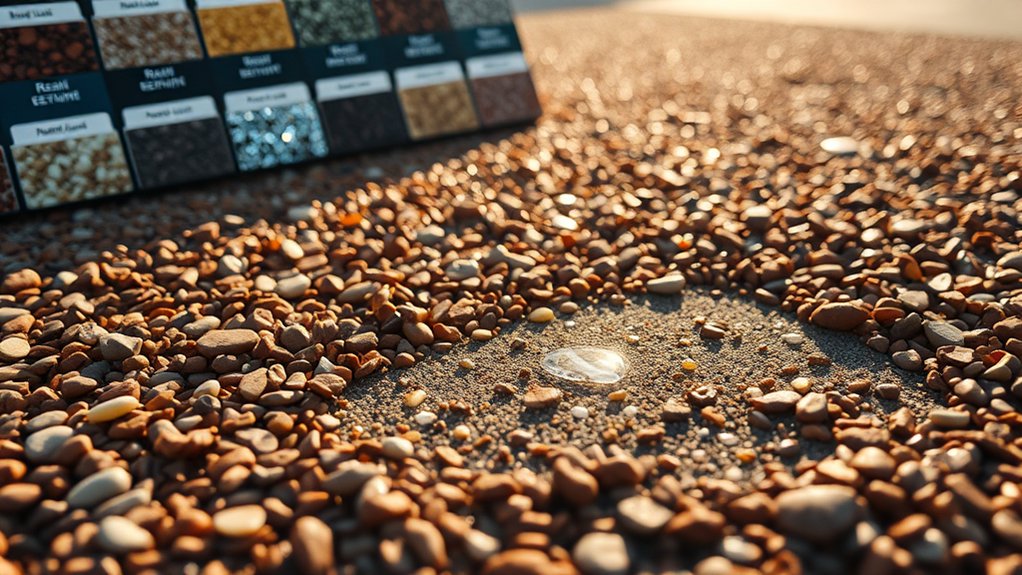
Choosing UV-resistant materials for resin-bound gravel is essential to prevent fading and discoloration. UV-resistant (UVR) resins, which use aliphatic chemistry, offer better protection than standard resins – much like how quality sunscreen shields your skin. Though UVR resins cost more upfront, they’re a smart investment that prevents costly touch-ups later. The quality of your aggregate matters just as much. Use kiln-dried, washed stones to avoid any dirt or debris that might interfere with the resin’s performance. Clean dried aggregate is vital to ensure the best adhesion and finish for your project. Furthermore, selecting a premium material enhances the structural integrity of the driveway, providing long-lasting durability. Think of it like painting a wall – you need a clean surface for the best results. Check that your aggregates are uniform in size and properly graded to match your chosen resin.
Best Practices for Installation
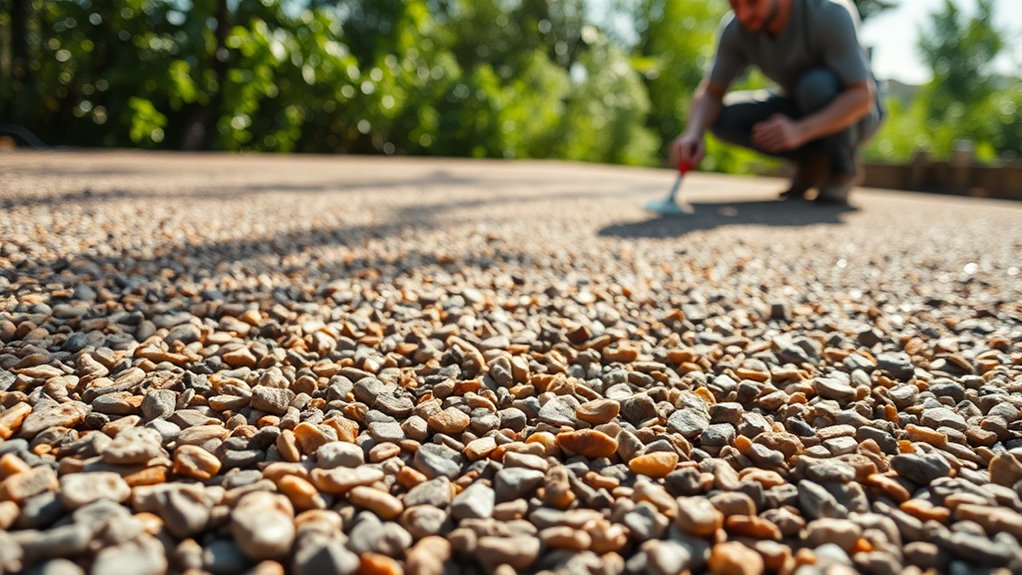
Best Practices for Installation
After choosing quality UV-resistant materials, focus on proper installation for lasting results and visual appeal. Clean all surfaces thoroughly and control moisture levels for optimal adhesion. Mark out a grid pattern and use masking tape for clean edges. Ensuring that the existing surface is clean will significantly enhance the adhesion of the resin-bound gravel, as proper ground preparation is crucial for preventing future damage and instability.
| Installation Techniques | Quality Control |
|---|---|
| Surface Cleaning | Inspect for defects |
| Temperature Control | Maintain dry conditions |
| Priming | Follow curing steps |
| Levelling | Use adjustable applicators |
| Upstands | Check laying speed |
Mix and apply resin swiftly, using the correct resin-to-aggregate mix (like making sure you’ve got the right amount of milk in your tea). Regular checks during laying ensure quality, resulting in a tough, attractive resin-bound gravel surface that won’t fade or discolour.
Cleaning and Maintenance Tips
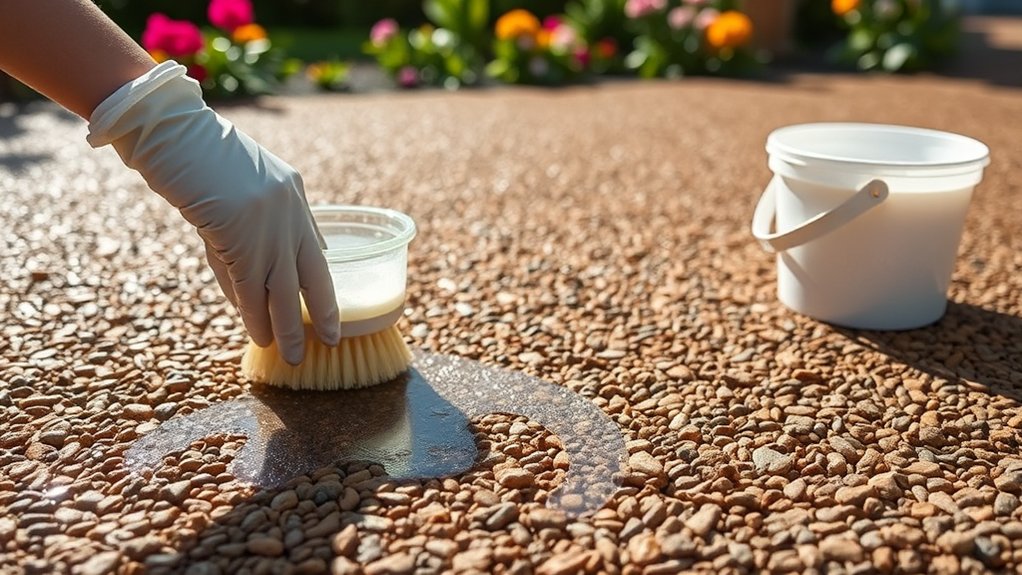
Regular cleaning keeps resin-bound gravel looking smart and extends its lifespan. Use a stiff brush weekly, working in circles to shift leaves and loose stones before they bed into the surface. Give it a quick rinse with your garden hose to wash away dust and grit. For stubborn marks, a pressure washer works well – just keep it on low power and about 30cm from the surface to avoid damage. After stormy weather, clear any debris straight away, as preventing moisture accumulation is crucial for maintaining the surface’s integrity. These simple habits will keep your resin-bound surface in top condition for years, as maintaining permeability is essential to prevent flooding and puddles.
Protective Measures to Prevent Damage
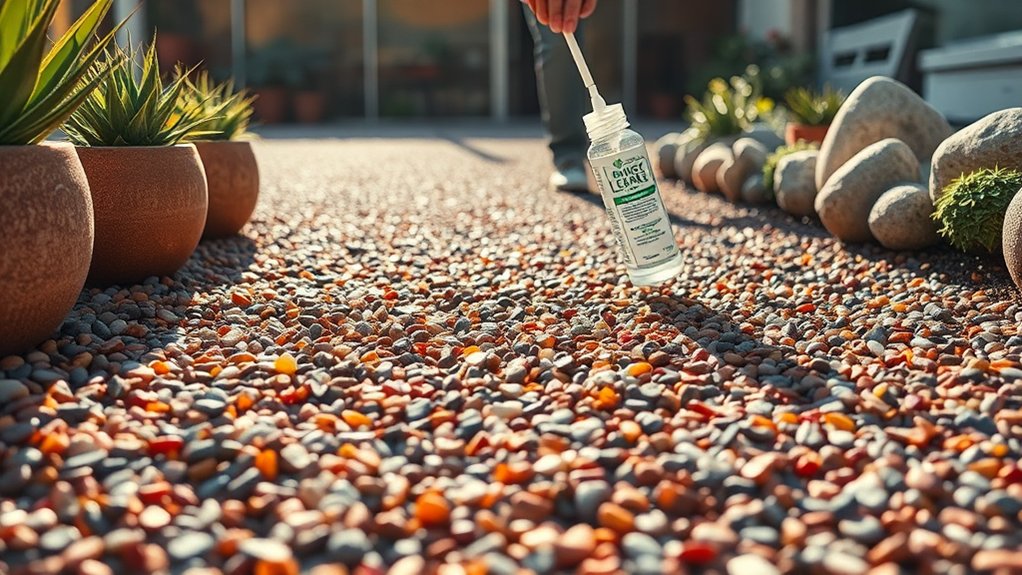
Essential Protection for Resin-Bound Surfaces
Whilst regular upkeep keeps your resin-bound gravel in good nick, these protective measures help prevent costly damage:
- Surface Sealing: Pop on a UV-resistant sealant to stop fading and extend your surface’s life. Much like sunscreen for your driveway, it guards against harsh weather.
- Edge Stability: Fit sturdy edging strips – concrete or metal work best. Skip plastic alternatives, as they tend to buckle under pressure.
- Base Preparation: Sort a proper sub-base that meets UK DoT standards, particularly vital for driveways and high-traffic spots.
- Drainage Planning: Get the water flow right. Poor drainage leads to puddles, which can leave nasty stains and weaken the surface – rather like leaving a wet glass on wooden furniture.
Repair and Restoration Techniques

Repairing Resin-Bound Gravel Surfaces
Tackle discolouration and damage on resin-bound surfaces promptly to maintain their appearance and function. First, assess the damage type and extent.
Give the surface a thorough clean with a pressure washer to shift dirt and debris. For cracks, use a chisel to widen them slightly before filling with epoxy or polyurethane – much like filling a cavity before it worsens.
Ensure the repair blends smoothly with surrounding areas and leave it to cure for 48 hours.
To restore faded surfaces, use specialist products like BoundWorx® Restore to bring back the shine and fix any blooming (white patches).
For extra grip, particularly useful for sloped driveways or paths, scatter fine glass grit onto the surface.
Check your surface regularly and sort repairs quickly – it’s like servicing your car, prevention is better than cure.
Frequently Asked Questions
How Long Can I Expect My Resin-Bound Surface to Last?
A properly installed resin-bound surface typically lasts 15-25 years. Regular maintenance, including sweeping, pressure washing and periodic resealing, ensures maximum durability. Much like caring for a paved driveway, good drainage and prompt removal of leaves or debris will keep your resin surface looking fresh whilst preventing damage.
Can I Use Colored Aggregates for a Unique Look?
Coloured aggregates offer a creative way to enhance your outdoor space. These decorative stones come in various shades and can transform driveways, paths and garden features into eye-catching displays. Popular choices include warm terracotta, classic white limestone and sleek black basalt – all whilst maintaining the durability you’d expect from standard aggregates.
Is UV Protection Necessary for Indoor Installations?
UV protection isn’t essential for indoor installations. Indoor lighting poses minimal UV risk, so it’s better to focus on resins that offer strong chemical resistance and surface durability. Regular cleaning and proper fitting are far more important for maintaining the installation’s quality and looks over time.
What Climate Conditions Affect Resin-Bound Surfaces the Most?
Resin-bound surfaces are highly sensitive to British weather conditions. Extreme temperatures and moisture present the biggest challenges to their longevity. During winter, freeze-thaw cycles can weaken the surface – much like what happens to poorly maintained garden paths. Summer installations face their own hurdles, as high humidity whilst curing (similar to painting in damp conditions) can prevent proper bonding. Regular upkeep, particularly after harsh weather spells, helps maintain the surface’s integrity.
How Do I Choose the Right Contractor for Installation?
When selecting a contractor, check their credentials and track record with resin-bound installations. A proper contractor should hold relevant qualifications, share photos of past work and provide local references. Ask if they’re members of recognised trade bodies like TrustMark or the Resin Flooring Association (FeRFA). Request proof of insurance and get detailed quotes in writing to avoid surprises later.
Conclusion
To maintain colour in resin-bound gravel:
Select UV-stable materials, ensure proper installation and carry out regular maintenance. Keep the surface clean and protect it from harsh chemicals or prolonged standing water. Much like caring for a garden path, these simple steps help prevent discolouration and extend the life of your investment. With proper attention, your resin surface will retain its appearance for years.
